Truth or Fiction
Breaking Down the Misinformation & Disinformation Ecosystem. I’ve written quite a bit about misinformation and disinformation in online, social spaces.
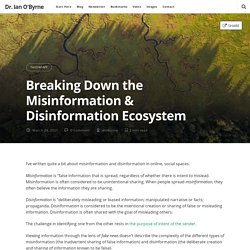
Misinformation is “false information that is spread, regardless of whether there is intent to mislead. Misinformation is often considered to be unintentional sharing. When people spread misinformation, they often believe the information they are sharing. Disinformation is “deliberately misleading or biased information; manipulated narrative or facts; propaganda. Disinformation is considered to be the intentional creation or sharing of false or misleading information. The challenge in identifying one from the other rests in the purpose of intent of the sender.
There's no such thing as 'alternative facts'. 5 ways to spot misinformation and stop sharing it online. The blame for the recent assault on the US Capitol and President Donald Trump’s broader dismantling of democratic institutions and norms can be laid at least partly on misinformation and conspiracy theories.
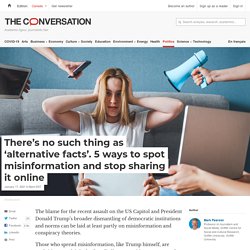
Those who spread misinformation, like Trump himself, are exploiting people’s lack of media literacy — it’s easy to spread lies to people who are prone to believe what they read online without questioning it. We are living in a dangerous age where the internet makes it possible to spread misinformation far and wide and most people lack the basic fact-checking abilities to discern fact from fiction — or, worse, the desire to develop a healthy skepticism at all. Read more: Stopping the spread of COVID-19 misinformation is the best 2021 New Year’s resolution Journalists are trained in this sort of thing — that is, the responsible ones who are trying to counter misinformation with truth. 1.
Civic Online Reasoning. Can you spot the problem with these headlines? (Level 1) -
Sometimes a health headline will focus on a study done in mice, or done with only 2 people, or done by forcing people to run hundreds of miles a day.

The farther the study is from who you are and how you act in your real life, the less likely the results will translate directly to you. For example, the Physicians Health Study is a well-known study that was conducted in the 1980s that demonstrated that aspirin reduced the risk of having a heart attack. The observed effect was very strong and lead to headlines such as: “Health; Doctors Confirm Benefits of Aspirin”, however this study was only conducted among men, and since it has been demonstrated that the effect may not be the same for women.
Does this mean the original study was wrong? Of course not! In our videos, we briefly discuss the design of a study, for example paying attention to whether there is a control group. If the impact of the exposure, like a drug or diet, is pretty small we call that a small effect size.
Welcome to the Spot the Troll Disinformation Quiz. The News Literacy Project. Bad News. Factitious. AMF Media Literacy Lab. A Nixon Deepfake, a 'Moon Disaster' Speech and an Information Ecosystem at Risk. What can former U.S. president Richard Nixon possibly teach us about artificial intelligence today and the future of misinformation online?
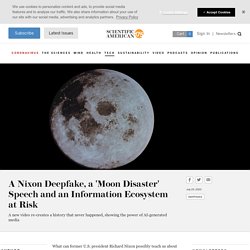
Nothing. The real Nixon died 26 years ago. But an AI-generated likeness of him shines new light on a quickly evolving technology with sizable implications, both creative and destructive, for our current digital information ecosystem. Starting in 2019, media artists Francesca Panetta and Halsey Burgund at the Massachusetts Institute of Technology teamed up with two AI companies, Canny AI and Respeecher, to create a posthumous deepfake. The synthetic video shows Nixon giving a speech he never intended to deliver—half a century after the subject it addresses. Here’s the (real) backstory: In July 1969, as the Apollo 11 astronauts glided through space on their trajectory toward the moon, William Safire, then one of Nixon’s speechwriters, wrote “In Event of Moon Disaster” as a contingency.
The full deepfake speech can be viewed at. In Event of Moon Disaster. How to Spot Bullshit: A Primer by Princeton Philosopher Harry Frankfurt. We live in an age of truthiness.
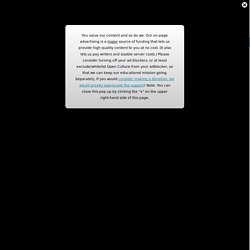
Comedian Stephen Colbert coined the word to describe the Bush administration’s tendency to fudge the facts in its favor. Ten years after the American Dialect Society named it Word of the Year, former president Bush’s calendar is packed with such leisure activities as golf and painting portraits of world leaders, but "truthiness" remains on active duty. It’s particularly germane in this election year, though politicians are far from its only practitioners. Take global warming.
What Would Michel Foucault Think of Social Media, Fake News & Our Post Truth World?
During the late 70s, Michel Foucault gave a series of lectures at the College de France in which he defined the concept of biopolitics, an idea Rachel Adams calls “political rationality which takes the administration of life and populations as its subject.”
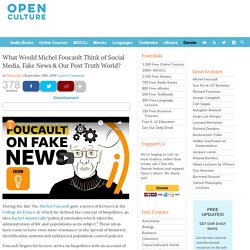
These ideas have come to have even more resonance in the spread of biometric identification systems and militarized population control policies. Foucault begins his lecture series on biopolitics with an account of the birth of Neoliberalism, the engineered privatization of public goods and services and the concentration of capital and power into the hands of a few. “Everything I do,” he once said, “I do in order that it might be of use.” What would he have to say about the current situation?
Deepfakes: Is This Video Even Real?
Web Literacy for Student Fact-Checkers – Simple Book Production. The rise of fake online reviews and how to spot them. We’ve all been there – trawling through online reviews while booking a hotel or restaurant and there’s one place you’ve never heard of with overwhelmingly positive recommendations.

But how much can we really trust them? Last year, the ACCC took action against businesses such as Service Seeking, Meriton, and Aveling Homes for engaging in misleading conduct relating to customer reviews. The New Daily found several examples of advertisements on job websites blatantly seeking a “fake review writer”.
Navigating the Information Landscape: Resources for Young People. As librarians, we are continually challenged and tasked with creating programming that teach multiple literacies — including information literacy, digital literacy, news literacy and media literacy — in fun, engaging and interactive ways.
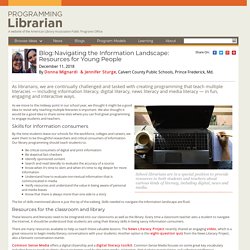
School librarians are in a special position to provide resources to both students and teachers about various kinds of literacy, including digital, news and media. As we move to the midway point in our school year, we thought it might be a good idea to revisit why teaching multiple literacies is important. We also thought it would be a good idea to share some sites where you can find great programming to engage students and teachers. Skills for information consumers By the time students leave our schools for the workforce, colleges and careers, we want them to be thoughtful researchers and critical consumers of information.
Library/Media Center / 7th Grade SS Fake News. Lesson Plan: How to Spot Fake News.
The problem of fake news came to a dizzying head in 2016 when a man fired a shot in a family pizzeria as he “self-investigated” a false report of a child abuse ring led by top democrats.
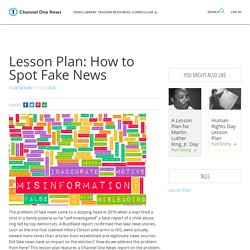
A BuzzFeed report confirmed that fake news stories, such as the one that claimed Hillary Clinton sold arms to ISIS, were actually viewed more times than articles from established and legitimate news sources. Did fake news have an impact on the election? How do we address the problem from here? This lesson plan features a Channel One News report on the problem. Then, students analyze the problem and consider steps media outlets and individuals need to take to prevent the viral spread of propaganda. Opening Activity. The Honest Truth about Fake News ... and How Not to Fall for It (with Lesson Plan)
How to outsmart fake news in your Facebook feed. It doesn't have to be this way.
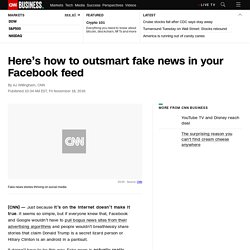
Fake news is actually really easy to spot -- if you know how. Consider this your New Media Literacy Guide. 1. Does the story come from a strange URL?
‘Who shared it?’ How Americans decide what news to trust on social media. Published 03/20/17 8:00 am This research was conducted by the Media Insight Project — an initiative of the American Press Institute and the Associated Press-NORC Center for Public Affairs Research Introduction When Americans encounter news on social media, how much they trust the content is determined less by who creates the news than by who shares it, according to a new experimental study from the Media Insight Project, a collaboration between the American Press Institute and The Associated Press-NORC Center for Public Affairs Research.
Battling Fake News in the Classroom. In this post-election period, there has been a lot of discussion about fake news, particularly about how it is spread and shared online, and whether it influenced the recent presidential election.
On November 22, Stanford University released an influential study showing that middle and high school students—and even some in college—have trouble distinguishing which online resources are credible. The inescapable fact is that young people need to be prepared for the Wild West of information that they live in and will grow up in. It is also imperative that we, as educators, prepare young people for the important job of responsible and informed citizenship.
Search, fake news and politics - an international study. How are people using search, social media and other forms of media to get information about politics, politicians and political issues? Are we right to be worried about the impact search algorithms have on shaping political opinions or about inaccurate, false and politically biased information that distorts public opinion?
A study, conducted jointly by researchers from the Oxford Internet Institute (University of Oxford) and the Quello Center (Michigan State University) questioned 14,000 internet users from France, Germany, Italy, Poland, Spain, the UK and the USA about how they used traditional and online media. Search performance has the potential to support or undermine democratic processes.
Face2Face: Real-time Face Capture and Reenactment of RGB Videos (CVPR 2016 Oral)
The Long and Brutal History of Fake News. The fake news hit Trent, Italy, on Easter Sunday, 1475. A 2 ½-year-old child named Simonino had gone missing, and a Franciscan preacher, Bernardino da Feltre, gave a series of sermons claiming that the Jewish community had murdered the child, drained his blood and drunk it to celebrate Passover. The rumors spread fast. Before long da Feltre was claiming that the boy’s body had been found in the basement of a Jewish house. In response, the Prince-Bishop of Trent Johannes IV Hinderbach immediately ordered the city’s entire Jewish community arrested and tortured. Fifteen of them were found guilty and burned at the stake.
69 Viral Images From 2016 That Were Totally Fake. Fighting Fake News. Librarians—whether public, school, academic, or special—all seek to ensure that patrons who ask for help get accurate information.
Given the care that librarians bring to this task, the recent explosion in unverified, unsourced, and sometimes completely untrue news has been discouraging, to say the least. According to the Pew Research Center, a majority of US adults are getting their news in real time from their social media feeds. These are often uncurated spaces in which falsehoods thrive, as revealed during the 2016 election.
To take just one example, Pope Francis did not endorse Donald Trump, but thousands of people shared the “news” that he had done so.
Fake News Archives. How to Spot Fake News. Fake news is nothing new. But bogus stories can reach more people more quickly via social media than what good old-fashioned viral emails could accomplish in years past.
NPR Choice page. Good Tools for Teaching Students How to Evaluate Web Content Credibility.
How To Spot Fake News. How to Spot Fake News: Triangulation for Communications Pros Spin Sucks. A Conspiracy Video Teaches Kids A Lesson About Fake News. Seven Ways to Identify Pseudoscience. Original seven ways – © Relatively Interesting The use of psychobabble – words that sound scientific and professional but are used incorrectly, or in a misleading manner; Self-help books, folk and pop psychology, and motivational seminars often use psychobabble.
Renee Hobbs at the Media Education Lab. Web Evaluation: Does This Website Smell Funny to You?
RADAR Framework - Evaluating Sources: Using the RADAR Framework - LibGuides at Loyola Marymount University. Library Creates Genius Bookmark To Teach Students How To Spot Fake News.
'Fiction is outperforming reality': how YouTube's algorithm distorts truth. It was one of January’s most viral videos. Logan Paul, a YouTube celebrity, stumbles across a dead man hanging from a tree. The 22-year-old, who is in a Japanese forest famous as a suicide spot, is visibly shocked, then amused.
Breaking News Consumer's Handbook. To Test Your Fake News Judgment, Play This Game : NPR Ed. Fake news has been on Maggie Farley's mind further back than 2016 when President Trump brought the term into the vernacular.
Fake News: Recommendations - Media Literacy Clearinghouse. If you read any news story about “fake news” in the past 18 months, you no doubt came across the phrase “media literacy.”
From the various news stories and blog posts, I have compiled the following recommendations and advice. (NOTE: lesson plans, handouts and related videos are posted near the bottom of this list) Newest materials are posted last.
Beers & Probst: Responsible Reading and Fake News. By Kylene Beers & Robert Probst. MIL as Composite Concept. How Media Literacy Can Help Students Discern Fake News - Teaching and Learning - Education Week Video. How To Spot Fake News. Truth, truthiness, triangulation: A news literacy toolkit for a “post-truth” world.
Top 10 sites to help students check their facts. Six easy ways to tell if that viral story is a hoax. Digital & Media Literacy. Media/news literacy resources too good to miss!
National Association for Media Literacy Education. Media Literacy Clearinghouse. GO TenQuestionsForFakeNewsFINAL. Lesson Plan: How to Spot Fake News. The Fake News Culprit No One Wants to Identify: You. The Future of Fake News. How Wikipedia Tackles Fringe Nonsense.
10 Hilarious Hoax Sites to Test Website Evaluation. Turning Your Students Into Web Detectives. Calling Bullshit.
Calling Bullshit 1.1: Introduction to Bullshit. How to spot a misleading graph - Lea Gaslowitz. How to sharpen students' critical thinking skills online. Lexicon of Lies: Terms for Problematic Information. [infographic] Fake news or real news? 10 tips to getting the facts for yourself - Stone Soup Creative. Factitious. Harvard Students Launch a Free Course on How to Resist Trump. Media Manipulation and Disinformation Online. Top 10 sites to help students check their facts. Fake news. It's complicated. - First Draft News. Web Literacy for Student Fact-Checkers Is Out. Threat Encyclopedia. New Articles on snopes.com.
Rumors, hoaxes, and urband legends - TruthorFiction.com.










